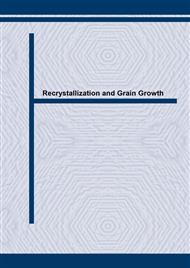p.75
p.81
p.87
p.93
p.99
p.107
p.117
p.123
p.129
Orientation Aspects of the Recrystallization Nucleation in Highly Deformed Polycrystalline Copper
Abstract:
The orientation dependence of recrystallization nucleation in 95% cold-rolled polycrystalline copper was studied by means of electron microscopy and calorimetry. Local orientation characteristics of microstructure at the beginning of recrystallization process were analyzed. Combined calorimetric and microscopic investigations, including local orientations measurements, imply that recrystallization is a superposition of several local processes that develop in two steps. In the first step, discussed in this paper, recrystallization process develops in the areas of localized strain, including shear bands and regions of more or less distorted matrix subgrains. Orientations of nuclei reproduce all components of deformation texture. Further growth of nuclei is accompanied by selective generation of successive recrystallization twins. In fact, not single grains are growing, but entire colonies comprising the nuclei developed from fragments of deformed matrix and recrystallization twins [e. g. 1].
Info:
Periodical:
Pages:
99-106
Citation:
Online since:
October 2004
Authors:
Price:
Сopyright:
© 2004 Trans Tech Publications Ltd. All Rights Reserved
Share:
Citation:


